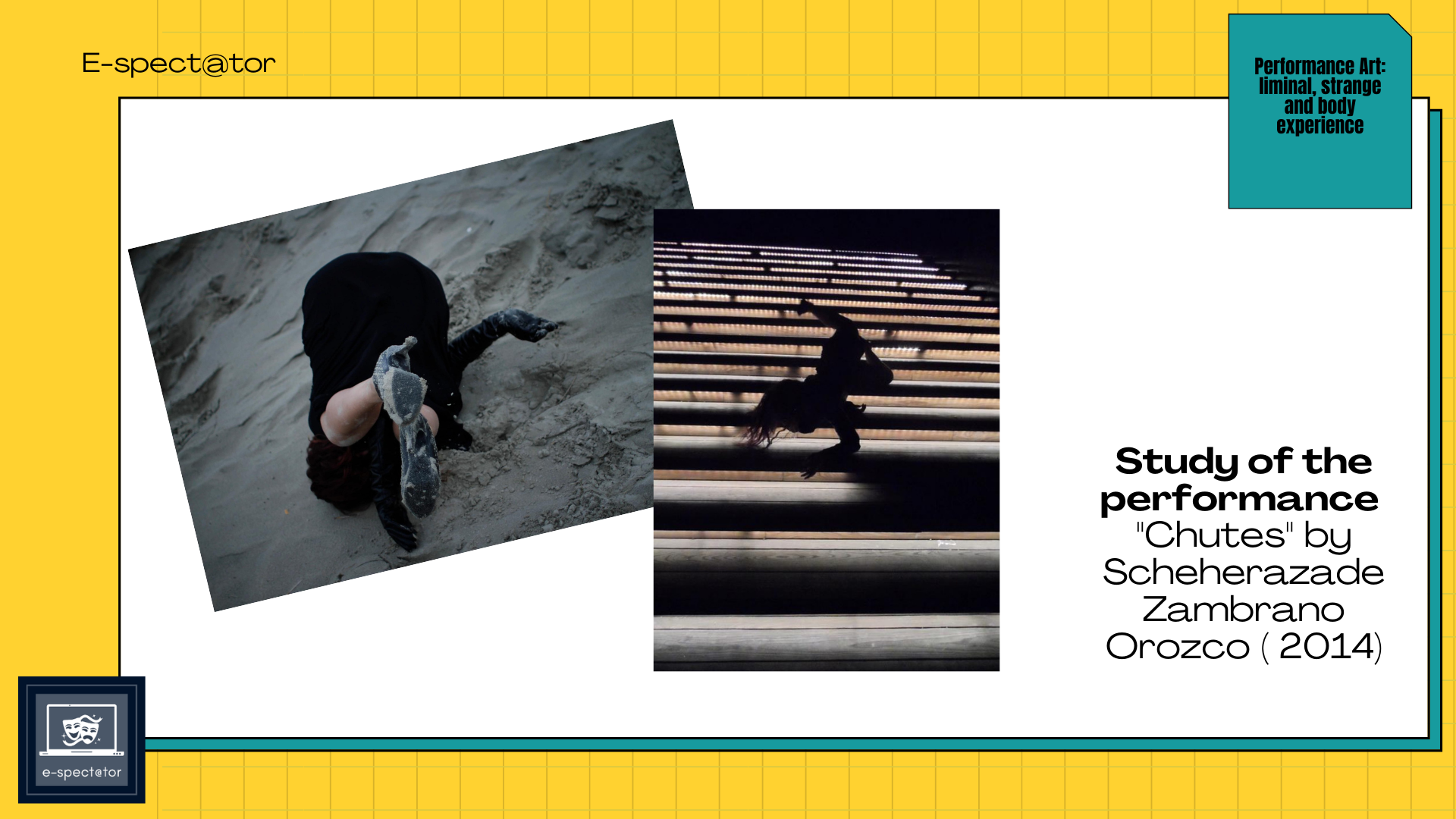2.4 Performance Art: liminal, strange and body experience
2.4.1 "Chutes" by Scheherazade Zambrano Orozco

This study on the performance entitled Chutes by the Mexican dancer and choreographer Scheherazade Zambrano Orozco is based on the theoretical presentation on performance art in Unit I of this course.
The performance Chutes took place in March 2014 at the Université Polytechnique des Hauts de France (Valenciennes, France) and was the subject of a video recording on which this study is based.
Before going through the case study, here are a few instructions you can follow using the digital tool e-spect@tor or not:
A. Without using the e-spect@tor tool
1) Please watch the video first, without taking notes: in this way, you can be fully aware of most of the different aspects of the performance (as if you were attending the live show).
B. Using the e-spect@tor tool
First, please read the guidelines to create your account on the e-spect@tor tool and connect to it following the instructions in Unit III.
1) Once connected to the e-spect@tor tool, please join the project Chutes using the code: chutes-60j0dq-Rgs6Or
2) Please start watching Chutes first, using the performance mode: in this way, you can't stop the run of the video as if you were attending the live show. Also, as if you were attending a live show for the first time, you can annotate free comments (like association of ideas) and use the set of emoticons to declare your emotions and basic opinions.
3) Please watch the video a second time using the analysis mode :
This time, you can stop, forward and reward the video for paying attention to performative elements you consider relevant to analyze. In addition to the set of emoticons and free comments, you are now allowed to use the ontology to draw your interest in different categories of performative components such as "staging", "acting", "dramaturgy" (run of the action) and "audience response" (reception).
Start annotating the video of Chutes considering the performative components you detect according to three points:

Before going through the case study, here are a few instructions you can follow using the digital tool e-spect@tor or not:
A. Without using the e-spect@tor tool
1) Please watch the video first, without taking notes: in this way, you can be fully aware of most of the different aspects of the performance (as if you were attending the live show).
2) Watch it a second time and take notes about the performative components according to three points:
- The location of the performance (where did it take place? What is the performance space?...) and its main impact on you.
- The commitment of the performer's body during the live work and what it conveys to her and the audience.
- The peculiar vision of the world suggests the performance to the spectators.
B. Using the e-spect@tor tool
First, please read the guidelines to create your account on the e-spect@tor tool and connect to it following the instructions in Unit III.
1) Once connected to the e-spect@tor tool, please join the project Chutes using the code: chutes-60j0dq-Rgs6Or
2) Please start watching Chutes first, using the performance mode: in this way, you can't stop the run of the video as if you were attending the live show. Also, as if you were attending a live show for the first time, you can annotate free comments (like association of ideas) and use the set of emoticons to declare your emotions and basic opinions.
3) Please watch the video a second time using the analysis mode :
This time, you can stop, forward and reward the video for paying attention to performative elements you consider relevant to analyze. In addition to the set of emoticons and free comments, you are now allowed to use the ontology to draw your interest in different categories of performative components such as "staging", "acting", "dramaturgy" (run of the action) and "audience response" (reception).
Start annotating the video of Chutes considering the performative components you detect according to three points:
- The location of the performance (where did it take place? What is the performance space?...) and its main impact on you.
- The commitment of the performer's body during the live work and what it conveys to her and the audience.
- The peculiar vision of the world suggests the performance to the spectators.

Chutes by Scheherazade Zambrano Orozco, Université Polytechnique des Hauts de France, Valenciennes, Bâtiment Matisse

